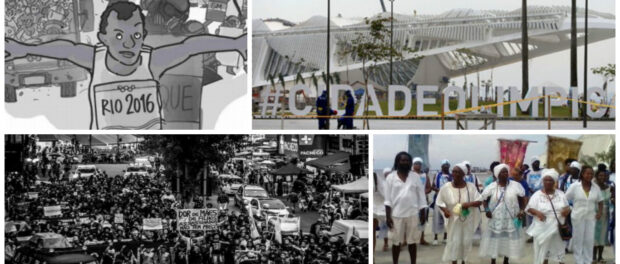
The final month of 2015 offered a moment to take stock of the state of affairs in Rio and Brazil before 2016, the Olympic year, began. With summaries of human rights violations and analyses of international media coverage, alongside ongoing coverage of key issues like Vila Autódromo and continuing violence against black favela residents, we’re ready to enter the most critical year ever for amplifying favela perspectives. To help our readers digest the major news and themes of the past month, we’ve summarized the stories we published here on RioOnWatch along with a few other must-reads in the media. Access all our monthly summaries here and full digests here.
Before entering 2016 and the culmination of RioOnWatch, a project Catalytic Communities started in 2010 to document the transformations taking place in Rio through the 2016 Olympic Games, we looked back at 2015 with our latest analysis of the best and worst international reporting on Rio’s favelas. Two of the excellent articles were from December itself: a ground-breaking and highly visible feature on Vila Autódromo in TIME and a story on pre-Olympic evictions in Vice, both of which the CatComm team was thrilled to support.
Our own coverage of Vila Autódromo included an analysis of the escalating and utterly oppressive pressures mounting as the City grapples with the short timeframe they have to pressure residents they have previously promised could stay. We covered the terrifying eviction story of Dona Mariza, who was left homeless when her home was destroyed in October, and creative resistance events that continue on a weekly basis in this relentless community, such as the #OcupaVilaAutodromo cultural festival and civil disobedience by residents as they came together to work on their long-awaited daycare center.
This month the Popular Committee on the World Cup and Olympics published their biggest and most extensive dossier of human rights violations ahead of the Rio 2016 “Exclusion Games.” Over 22,059 families have now been removed from their homes across Rio. For human rights like the right to housing, residents of Brazilian cities and judicial officials alike lack knowledge of favela residents’ hard-won legal rights. During the same week as the dossier launch, hundreds of activists debated and some 50,000 people celebrated International Human Rights Day in Madureira.
Madureira was also the site of a powerful protest against the killings of black youth, following police inexplicably killing five youth in Costa Barros. As a form of reflection on and resistance to ongoing violence, women in Caju and Manguinhos mapped violence in their communities. Some favela activists say a focus on the struggle against systemic violence affecting black favela populations is one reason behind low favela resident participation in December’s protests against the impeachment of President Rouseff.
An article voicing outrage by Alemão activist-journalist Raull Santiago argues for the importance of reporting on rights violations, like police violence, while also showing the positive side of favelas, which is an act of resistance in itself. The temporary shutdown of WhatsApp in December and the resulting massive outrage (and humor) expressed by Brazilians of all backgrounds on social media underlined the key role of new Internet technologies and platforms in amplifying people’s voices.
Also this month, the highly anticipated yet controversial Museum of Tomorrow finally opened and an insightful CityLab article tackled the building’s complex symbolism in the Port region, critical to Afro-Brazilian heritage as the largest slave port in world history. Not too far from the museum, the Pedra do Sal quilombo and supporters celebrated ten years of recognition of the quilombo’s historical importance and the ongoing bid for recognition as a UNESCO World Heritage.
And finally, residents of Vila Laboriaux and collaborators revived a vacant plot of land with the aim to develop an edible urban forest for the community. This revitalization is one of several sustainable development and community improvement projects Vila Laboriaux residents are implementing, which is all the more remarkable given the government called for the community’s removal after landslides in 2010.
Look out for our next summary of articles from January as we enter the momentous Olympic year. For more information and links to favela news from the month, see our full Favela Digest for December 2015 here. You can subscribe to receive the Favela Digest straight to your inbox each month here.
